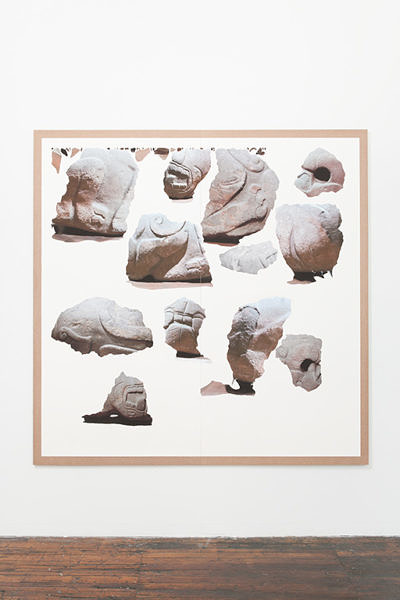3D Reproductions of objects from the Metropolitan Museum of Art, Inkjet on paper mounted on MDF, sintered nylon on laser-cut MDF tables
2014, Transfer Gallery, Brooklyn
Of the moral effect of the monuments themselves, standing as they do in the depths of a tropical forest, silent and solemn, strange in design, excellent in sculpture, rich in ornament, different from the works of any other people, their uses and purposes and whole history so entirely unknown with hieroglyphics explaining all, but being perfectly unintelligible, I shall not pretend to convey any idea. Often the imagination was pained in gazing at them.
— John Lloyd Stephens, Incidents of Travel in Central America, Chiapas, and Yucatan, 1841
This week, Twitterers around the world received some devastating news: The Twitter account @Horse_ebooks, a cult favorite, was human after all.
— Bianca Bosker, Twitter Hoax Reveals What We Desire Most From Machines, Huffington Post, Sept. 26, 2013
Surface Survey is comprised of digital prints and 3D printed sculptures, structured around concepts of archaeology, computer software, meaning-making, and images that are not meant for human consumption.
To explore these themes, Valla collects digital artifacts produced by software that turns photographs into 3D Models. The arranged fragments are left untouched, exhibiting the software’s process as-is. The work is comprised of both 2D images meant to be processed by the computer (but never seen by humans) and 3D printed fragments that indicate how the software pieces the shapes together.
Valla ‘s subjects are varied: from sculptural antiquities he photographed in the Metropolitan Museum’s collections, to contemporary ephemera, to 19th Century inventions. The work uncovers subtle shapes and textures that illustrate these objects in unexpected ways and cast a new light the algorithms that digitized them.
Valla’s work reflects on the human potential of meaning-making in unfamiliar, software-created images. He is interested in the relationship between how what a computer reads is so distant from what a human will understand. This interest extends into the language of computer image-making, suggesting an archaeology of computer software, whose extractions reveal the computer’s systematic logic.









